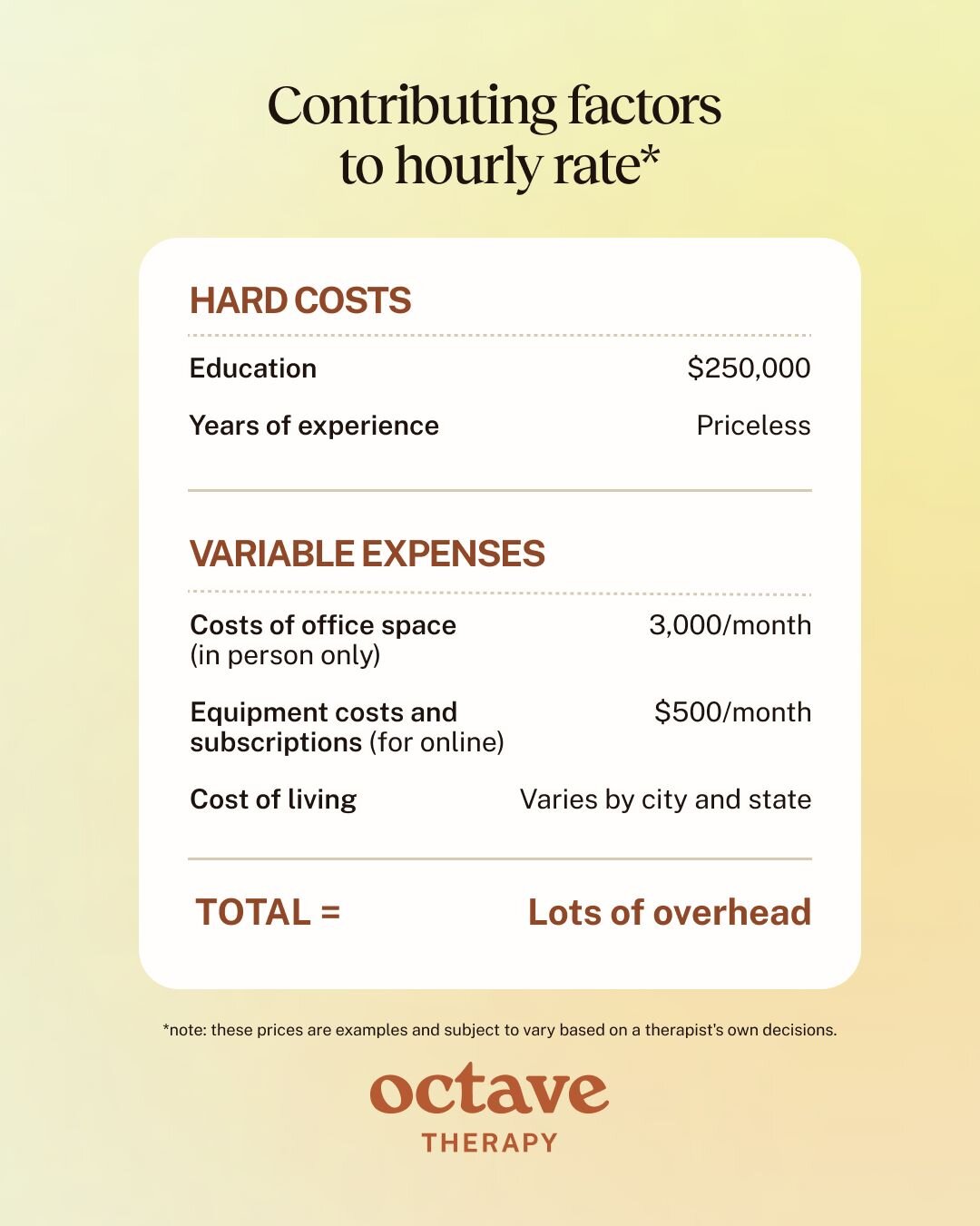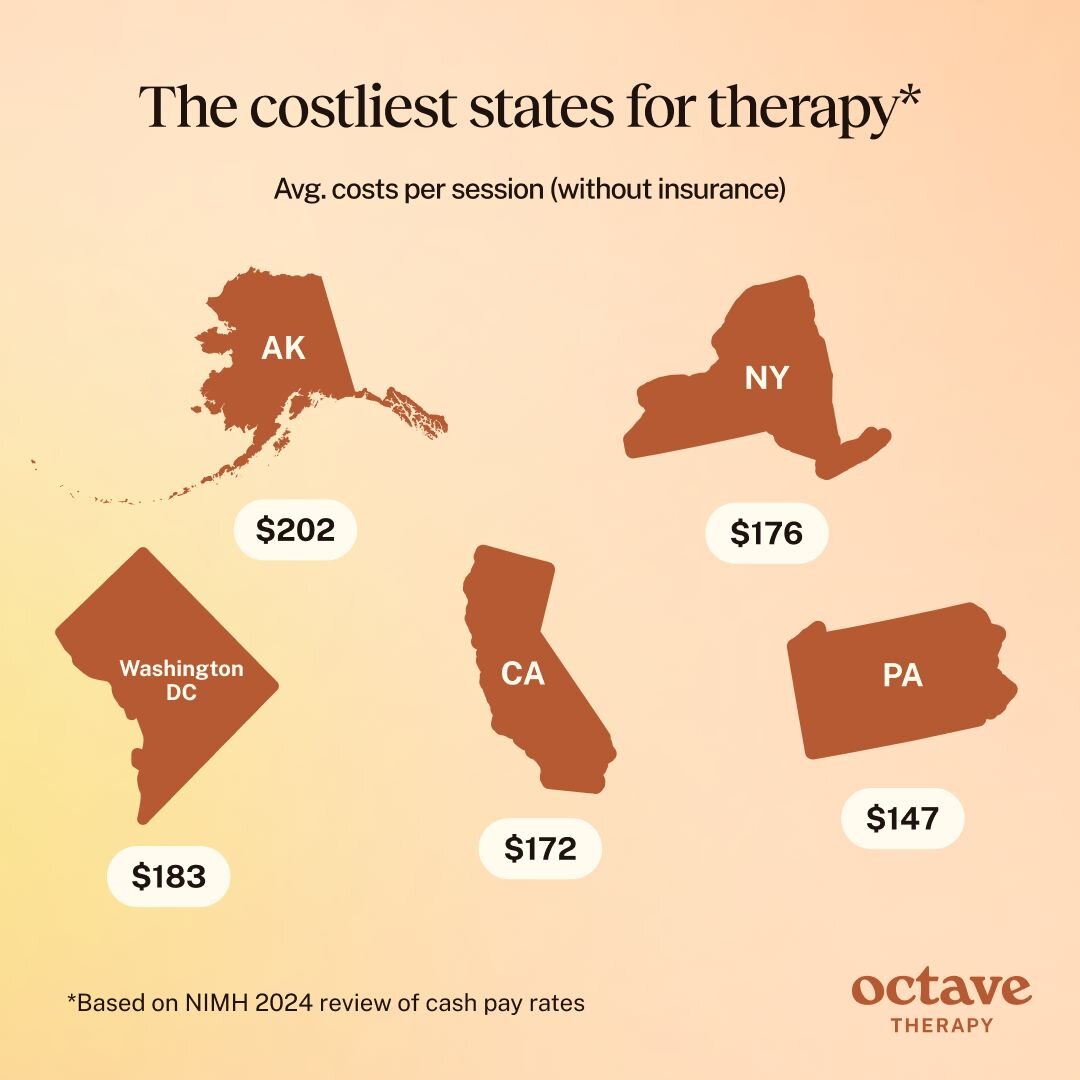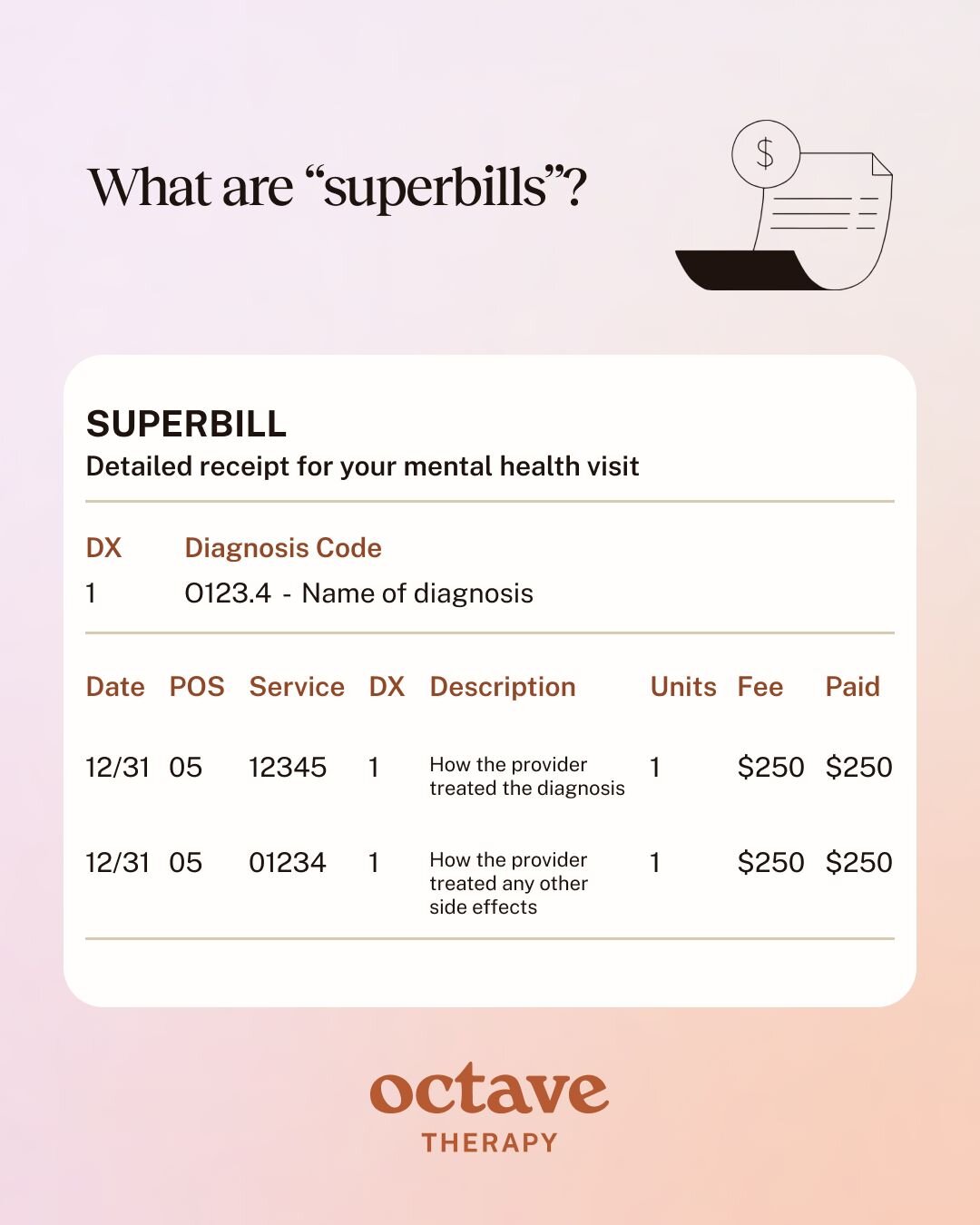
How Much Does Therapy Cost?
Overview
More than 1 in 5 people in the U.S. show symptoms of and manage a mental illness. Talk therapy can be one of the most practical methods of managing symptoms and getting on a path to healing.
However, therapy can be costly. That’s not without reason — a therapist must be fully present during the hour they spend with each client. The type of treatment needed, the severity of a person’s symptoms, experience level and specialties of the therapist, etc. all factor into the cost of therapy. Additionally, many clinicians are self-employed and the costs of business expenses (an office or tech equipment) and necessary continuing education impact their hourly rate. And those costs can even vary depending on the city or state, urban or rural environment, and where the therapist practices.
You still might wonder, is therapy worth it? When a person wants to start working on their concerns in therapy, they will likely want to attend consistently until they resolve their issue or issues. Even if a client sees their provider every other week, it can add up.
We’ll show you how much to expect to pay for therapy, and how to mitigate the monetary investment. That way, you can get the most value possible from the experience.
Therapy costs, explained
Without insurance, therapy sessions cost $100-$250 on average, paid out of pocket. At Octave, we work with insurance companies to offer access to therapy that costs $28 per session on average. A wide range of factors determine what you’ll pay, especially if a provider doesn’t take insurance at another practice.
What Factors Contribute to the Cost of Therapy?
There are two main factors that influence what you’ll pay out of pocket: A therapist’s hourly rate and your insurance coverage.
Hourly Rate
The first factor that determines how much you’ll pay in therapy is the hourly rate a therapist sets for themselves. Based on their level of education, skills, experience in practice, etc., a clinician will determine their hourly rate.
Main influences on hourly rate
- Education — while some licenses do not require a master’s degree, most need at least that, and many require a PhD.
- Years of experience — a clinician who is just getting their start after completing their education may charge less than someone with 20 or 30 years in practice.
- Type of therapy and required skills/specializations/certifications — certain types of therapy require a practitioner to gain more skills to practice responsibly. Similar to years of experience, each certificate a therapist has represents time and money invested into continuing education.
- Geography — not only does being in an urban or rural area impact business costs, but some states also require specific certifications and licenses (which cost money) to practice.
- Format — online therapy tends to be less expensive than in-person therapy, due to the lower startup costs and continued overhead.

For example, a psychologist who specializes in diagnosing and treating obsessive compulsive disorder (OCD) will likely have a higher hourly rate than a licensed professional counselor (LPC) who sees a wide range of clients with anxiety and depression. Not only is that because of the level of specialization, but it is also because the psychologist has to complete a PhD program, whereas the minimum level of education of an LPC is a master’s degree.
Insurance
The second influence on what you’ll pay out of pocket is insurance and whether or not a therapist is in your insurance’s network.
Categorization/coding
Insurance policies vary widely in terms of how they calculate your out-of-pocket expenses for in-network and out-of-network providers. Most insurance policies determine out-of-pocket costs differently for mental and behavioral health services (though under the Affordable Care Act, the costs must be comparable to what you’d pay for another form of healthcare). And if you have a high-deductible savings account policy, you’ll pay the hourly rate set by the therapist until you meet your deductible, regardless of how the insurance company codes each visit.
Contracted rates
Adding another layer of intricacy is contracted rates. Many therapists and mental health care providers do not take insurance at all, and this is why. If you’ve ever takefin a look at an itemized statement of benefits or a superbill, you’ll likely notice that your doctor’s office billed your insurance a certain amount. However, most doctor’s offices have a contracted rate for what the insurance company pays out. The idea is that because the doctor’s office gets significantly more business volume by taking insurance, they can give the insurance company a volume discount or price break.
What is the Average Cost of Therapy?
As we mentioned, the average cost of therapy in the United States ranges from about $100 to $250, depending on your state. However, based on the type of therapy you seek, costs may vary.
- In-person therapy average: $100-$250 per hour-long session
- Online therapy average: up to $250 per hour-long session
Note: this doesn’t factor in platforms who charge a monthly fee for your sessions or operate on a subscription-based model.
Average cost of therapy by type
Of course, all of these estimates are given with the assumption that it’s an individual who is seeking therapy. The cost usually changes when multiple people are involved.
- Individual therapy average: Up to $250 per hour-long session
- Couples therapy average: Up to $300 per hour; providers will charge an additional $50-$100 per hour, and sometimes sessions longer than one hour are recommended
- Family therapy average: Up to $400 per hour; providers may add on to their couples counseling rate at an additional $50-$100 per person after two people due to the complexity involved
One key difference between individual and couples or family therapy is that individual therapy is often the only type covered by insurance, unless the couples or family therapy is deemed medically necessary.

The costliest states for therapy*
Most likely, if you live on the East or West Coast in a major metropolitan area, you’ll be paying more for therapy. The following states have some of the highest average session rates in America:
- Alaska ($202)
- Washington DC ($183)
- Pennsylvania ($147)
- New York ($176)
- California ($172)
*Based on NIMH 2024 review of cash pay rates
Therapy Costs at Octave
Estimate your cost of care with us
Discover how much your insurance will cover for therapy sessions with Octave. Simply select your state and insurance provider to see your out-of-pocket costs. Save time and make informed decisions about your care.

Does Insurance Cover Therapy?
More than likely, yes! After the Affordable Care Act (ACA) was introduced, mental and behavioral health services became considered “essential health benefits.” All plans offered through the Health Insurance Marketplace® and most individual and small employer plans cover mental health services. It’s also worth reiterating: depression, anxiety, and other mental or behavioral health diagnoses are not considered pre-existing conditions by your insurance company.
However, just because you have mental health care coverage doesn’t mean that all therapists take insurance (more on that in a bit).
In-network vs. out-of-network benefits
Let’s talk a little bit more about how coverage works within and outside of the insurance company’s network.
If you find an in-network therapist, that means the therapist is under contract with the insurance company to provide care to the insurance company’s patients at a pre-determined rate. The insurance will pay all or part of the provider’s rate after you meet your deductible, and you’ll be responsible for what’s left (your co-pay), if applicable.
Out-of-network providers are anyone who doesn’t work with your specific insurance company or plan type (they might take other insurance), or providers who do not take insurance at all. Even if your provider is out-of-network, you may still be eligible for some reimbursement, depending on your plan’s co-insurance and out-of-pocket maximums. For example, if you are responsible for 100% of costs for out-of-network providers, but have an out-of-pocket max of only $1,000, you’d still be eligible for coverage after you hit your out-of-pocket max, so it would still be worthwhile to submit your superbills as claims.
Superbills
That brings us to superbills, which are sometimes referred to as “Charge Slips”, “Encounter Forms,” or “Fee Tickets.” Basically, it’s a detailed and comprehensive receipt for your visit. Any time you need insurance to reimburse you for an encounter — whether that’s because your therapist is in-network and requires you to pay the cost of the visit up front or because your clinician is out-of-network — you’ll need a superbill.
A superbill details the types of treatment provided with two important pieces of information. In short, a diagnosis code tells the insurance company what the provider treated, and the procedure code tells them how they treated it. Some insurance companies ask for additional information, but these are the most common and universal requirements.
Your insurance will review your superbill and reimburse you based on your plan’s coverage.

Why Do Some Therapists Not Accept Insurance?
While more Americans have access to comprehensive healthcare than ever, not every provider chooses to take insurance.
Clinicians may choose not to take insurance due to a number of factors including:
- The reimbursement rate insurance companies deem fair in that market for that therapy type,
- Administrative burden and the time needed to file paperwork
- Higher business expenses to cover and the reimbursement may not make sense for their practice
Reimbursement rates
Since most therapists are self-employed or work for small practices, they don’t have as much wiggle room on their expenses and hourly rates. An insurance company may only pay a portion of their hourly rate if it’s comparable to their other contracted rates, so therapists have a choice to make. Therapists must determine if accepting that rate is sustainable from a financial standpoint.
Time investment
As you probably understand from reading about superbills, paperwork must be completed to get reimbursement from an insurance company. In a 40-hour work week, a therapist might see 25-30 patients (though this varies depending on the number of hours they set). When you compound the volume of a therapist’s client load with the volume of paperwork to complete every week, it’s a significant time investment. And with manual human effort to complete the paperwork, errors may happen that slow down the process.
Therapists may feel they simply don’t have the time to finish all of the paperwork, or correct the mistakes when they happen.
Is There a Way to Get Therapy For Free?
It depends on your situation and location.
Many local free clinics do exist. Take a look at the HRSA’s directory to see the options in your area. Even though it’s not free, some clinics also offer sliding scale payment based on your current income.
Additionally, if you’ve already met your deductible for the year, you’ll either pay a significantly lower rate out of pocket (through co-insurance), or you won’t have to pay anything at all (if you’re on a high-deductible savings plan).
For some, that’s affordable, but for some, that’s not. If you’re uninsured or there are other reasons you can’t afford to pay for mental health care, you can also visit the Substance Abuse and Mental Health Services Administration (SAMHSA) website for how you can find free or low-cost care.
From the CDC:
If you or someone you know is struggling or in crisis, confidential, free, 24/7/365 help is available.
- Call or text 988
- Chat at 988lifeline.org
- TTY users can use their preferred relay service or dial 711 then 988
Note: The 988 line automatically routes calls by your phone's area code to the nearest crisis center.
— Golee Abrishami, PhD, Head of Clinical Care at OctaveAs someone who’s been practicing therapy for 20 years, I know the cost of therapy can be a daunting and unknown question, but don’t let fear deter you from getting the care you need. As therapists, we want to help you, and you’d be surprised what asking a few additional questions might uncover.

How Can I Get Started with Therapy?
As you now understand, calculating therapy costs comes with some complexity when you’re doing it on your own. You have to get very familiar with your policy, what it covers, and your insurance company’s network of providers. Then, when you book your appointment, you should verify that information to have a clear understanding of what you’ll be responsible for paying out of pocket.
Luckily, Octave does the legwork for you. We work directly with insurance companies to provide competitive and consistent contracted rates for our therapists. That addresses many of the challenges therapists face when deciding whether or not to take insurance. This model allows us to hire excellent providers and, most importantly, give you a clear answer on what each appointment will cost. And you can schedule an appointment right after finding out what you’ll pay, with many appointment options occurring within days. All without ever picking up the phone (though you can talk to a Care Navigator if you need help getting matched to the right therapist).
FAQs about the cost of therapy

Octave therapists accept Aetna, Cigna, BlueCross BlueShield and other major insurances in your state.
